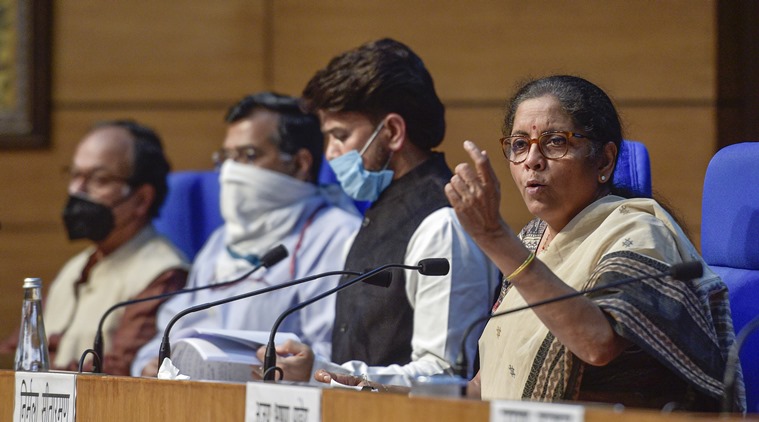- India
- International
Tight fist and fingers crossed: Fiscal relief this year is 1.1 per cent of GDP
In her fifth and final tranche of the AtmaNirbhar package announced on Sunday, Finance Minister Nirmala Sitharaman allocated a chunk of the Centre’s fiscal relief — Rs 40,000 crore or 0.2 per cent of GDP — as additional allocation to MGNREGA over and above the Budget Estimate of Rs 61,500 crore.
 The poor probably have not even got the bare minimum required to tide over the massive crisis as it continues to unravel with lakhs of migrant workers finding whatever means to reach homes. (PTI)
The poor probably have not even got the bare minimum required to tide over the massive crisis as it continues to unravel with lakhs of migrant workers finding whatever means to reach homes. (PTI)
In response to the biggest economic crisis since 1979 (worst drought since 1947 coupled with a global oil shock) triggered by the Covid-19 pandemic and a lockdown — one of the harshest in the world — the Central government’s fiscal relief of just 1.1 per cent of GDP is unlikely to mitigate its adverse impact on the economy.
Read | With migrants headed home, 65% hike in MNREGA funds
With most economic activities losing two months of output, leading domestic think tank National Council of Applied Economic Research (NCAER) Saturday estimated the economy to contract 12.5 per cent in 2020-21 in the absence of a stimulus, and the research division of global investment banking firm Goldman Sachs on Sunday projected a deeper trough in GDP growth — a 5 per cent decline compared with its April estimate of 0.4 per cent contraction. NCAER said public spending must be increased by an additional 3 per cent of GDP (Centre plus states) to register positive growth in 2020-21.
In her fifth and final tranche of the AtmaNirbhar package announced on Sunday, Finance Minister Nirmala Sitharaman allocated a chunk of the Centre’s fiscal relief — Rs 40,000 crore or 0.2 per cent of GDP — as additional allocation to MGNREGA over and above the Budget Estimate of Rs 61,500 crore. With lakhs of migrant workers continuing to return to their home states, the demand for MGNREGA scheme will most likely increase sharply in the ensuing months.
Read | With migrants headed home, 65% hike in MNREGA funds
In less than 45 days this financial year, the Central government had released funds to the tune of Rs 10,000 crore under the job guarantee scheme. It may be forced to increase the allocation further in the supplementary demand for grants in the coming months.
Much of the Rs 20 lakh crore Covid-19 economic package announced by Prime Minister Narendra Modi on May 12, and elaborated by Sitharaman over five consecutive days beginning May 13, has been liquidity driven, with little burden on the Central exchequer. It has been primarily aimed at pushing banks to extend credit on the back of government guarantees to sectors that fuel the economy — small businesses, non-banking financial companies, micro finance institutions and housing finance companies.

Read | Centre to pump Rs 40,000 crore more into MGNREGA for FY21
MSMEs alone contribute 28 per cent to the GDP, and 40 per cent to exports, besides providing jobs to 12 crore workers.
According to sources involved in discussions preceding the announcements, the political leadership had taken a call not to make large scale cash transfers early on, although it was still trying to get a sense of the extent of damage to the economy. “There is little fiscal space to distribute cash — even to the bottom of the pyramid, even if you call it relief, since there may be no sunset in sight,” a source told The Indian Express.
Don’t miss from Explained | Why the govt had to inject money into the power sector
To a question on why did the government not consider putting more money — Rs 5,000 to Rs 7,000 as recommended even by Nobel laureates — in the hands of the poor, Sitharaman said, “There are many ways to address the problem. What we did will have greater impact.”
For the full year, the government has already decided to borrow Rs 12 lakh crore, almost 50 per cent more than what was originally budgeted — Rs 7.8 lakh crore. “The higher borrowing was necessitated given the growth prognosis for the year, and the likely situation where tax revenues may slip by almost 2 per cent of GDP, if not more. In any case, the new borrowing target suggests the government’s Covid-19 related economic package cannot cost more than Rs 4.2 lakh crore or about 2.1 per cent of GDP,” said another source.
Read | Nirmala Sitharaman: Covid-related debts excluded from default under IBC
While the government took this opportunity to re-package and showcase some of old measures, and push new reforms in sectors such as agriculture, public sector enterprises, and defence production, it seems to have reconciled to the fact that the economy will dip sharply this year, and it’s probably best to just tide over the Covid-19 storm without drowning itself in a fiscal mess.
“Clearly, the government does not want to do anything in terms of financial support to big companies, many of which are also waiting to default on loans,” said another source, who was involved in the design of the package.
Read | Nirmala Sitharaman’s economic package: States get more headroom, but with conditions
The big positive is the government’s announcement of Rs 3 lakh crore collateral free loans to MSMEs, which are starved today, even for working capital, and to extend loans of about Rs 2 lakh crore to 2.5 crore farmers through Kisan Credit Cards. “The finance ministry and the RBI will exert pressure on risk-averse banks to extend loans to small businesses and farmers in the next few months. Equity infusion, collateral free loans, and subordinate debt for MSMEs are expected to give a lifeline to MSMEs,” said a government source.
The poor probably have not even got the bare minimum required to tide over the massive crisis as it continues to unravel with lakhs of migrant workers finding whatever means to reach homes.
Don’t miss from Explained | Breaking down Centre’s Atmanirbhar package
The money the poor got in their hands over the last two months following the Central government announcements has been just Rs 33,176 crore so far, Finance Minister Sitharaman said. The cash transfer to the poor includes Rs 10,025 crore to women Jan Dhan account holders, Rs 16,394 crore to farmers under PM Kisan Yojana (frontloading of payment without additional fiscal cost), Rs 2,807 crore to old persons, widows and the disabled, and Rs 3,950 crore to construction workers (also without any fiscal outgo since it is paid from the Building and Construction Workers’ Cess Welfare Fund).
With the Indian economy headed for its worst performance ever, there were expectations the government would take a leap on the fiscal front to stimulate demand.
Don’t miss from Explained | Gujarat’s Aatmanirbhar small loans scheme for the self-employed
But as The Indian Express reported almost a month back on April 22, there were early indications of a fiscally conservative approach. India, unlike many developed economies, cannot liberally open its purse strings. “With a BBB- sovereign rating, we still are investment grade. And unlike 2008 when the government’s fisc was in order and it could manage to give a massive stimulus, it doesn’t have the cushion now. One notch below BBB-, and India will slip into ‘speculative’ grade rating,” an official had then said.
This bears out almost a month later, with the announcement of the government’s Covid-19 economic package.
Apr 23: Latest News
- 01
- 02
- 03
- 04
- 05






































